Change in Environmental Benefits of Urban Land Use and Its Drivers in Chinese Cities, 2000–2010
Abstract
:1. Introduction
2. Materials and Methods
2.1. Prefectural Cities
2.2. Assessment of Environmental Benefits of Urban Land Use
2.3. Regression Model Specification
3. Results
3.1. Spatial Pattern of Environmental Benefits of Urban Land Use
3.2. Change in Environmental Benefits of Urban Land Use
3.3. Example: Environmental Benefits of Urban Land Use in Changzhou and Jiujiang
3.4. Regression Results
4. Discussion
4.1. Relationship between Income, Urban Population Growth, and Environmental Benefits
4.2. Implications for Sustainable Urban Land Use
5. Conclusions
Acknowledgments
Author Contributions
Conflicts of Interest
References
- Liu, T.; Liu, H.; Qi, Y. Construction land expansion and cultivated land protection in urbanizing China: Insights from national land surveys, 1996–2006. Habitat Int. 2015, 46, 13–22. [Google Scholar] [CrossRef]
- Gao, J.L.; Wei, Y.D.; Chen, W.; Chen, J.L. Economic transition and urban land expansion in provincial China. Habitat Int. 2014, 44, 461–473. [Google Scholar] [CrossRef]
- Gong, J.Z.; Chen, W.L.; Liu, Y.S.; Wang, J.Y. The intensity change of urban development land: Implications for the city master plan of Guangzhou, China. Land Use Policy 2014, 40, 91–100. [Google Scholar] [CrossRef]
- Ministry of Housing and Urban-Rural Development, P.R. China. China Urban Construction Statistical Yearbook; China Planning Press: Beijing, China, 2001. (In Chinese) [Google Scholar]
- Deng, X.Z.; Huang, J.K.; Rozelle, S.; Uchida, E. Growth, population and industrialization, and urban land expansion of China. J. Urban Econ. 2008, 63, 96–115. [Google Scholar] [CrossRef]
- Han, J.; Hayashi, Y.; Cao, X.; Imura, H. Application of an integrated system dynamics and cellular automata model for urban growth assessment: A case study of Shanghai, China. Landsc. Urban Plan. 2009, 91, 133–141. [Google Scholar] [CrossRef]
- Liu, J.Y.; Zhan, J.Y.; Deng, X.Z. Spatio-temporal patterns and driving forces of urban land expansion in China during the economic reform era. Ambio 2005, 34, 450–455. [Google Scholar] [CrossRef] [PubMed]
- Ma, Y.L.; Xu, R.S. Remote sensing monitoring and driving force analysis of urban expansion in Guangzhou City, China. Habitat Int. 2010, 34, 228–235. [Google Scholar] [CrossRef]
- Seto, K.C.; Fragkias, M.; Guneralp, B.; Reilly, M.K. A meta-analysis of global urban land expansion. PLoS ONE 2011, 6, 1–9. [Google Scholar] [CrossRef] [PubMed]
- Seto, K.C.; Kaufmann, R.K. Modeling the drivers of urban land use change in the Pearl River Delta, China: Integrating remote sensing with socioeconomic data. Land Econ. 2003, 79, 106–121. [Google Scholar] [CrossRef]
- Tan, M.H.; Li, X.B.; Lu, C.H. Urban land expansion and arable land loss of the major cities in China in the 1990s. Sci. China Ser. D 2005, 48, 1492–1500. [Google Scholar] [CrossRef]
- National Bureau of Statistics of China. China Statistical Yearbook; China Statistics Press: Beijing, China, 2011. (In Chinese)
- Population Census Office under the State Council Department of Population and Employment Statistics, National Bureau of Statistics. Tabulation on the Population Census of the People’s Republic of China; China Statistics Press: Beijing, China, 2000. (In Chinese)
- Deng, X.; Huang, J.; Rozelle, S.; Zhang, J.; Li, Z. Impact of urbanization on cultivated land changes in China. Land Use Polic. 2015, 45, 1–7. [Google Scholar] [CrossRef]
- Liu, J.; Kuang, W.; Zhang, Z.; Xu, X.; Qin, Y.; Ning, J.; Zhou, W.; Zhang, S.; Li, R.; Yan, C.; et al. Spatiotemporal characteristics, patterns, and causes of land-use changes in China since the late 1980s. J. Geogr. Sci. 2014, 24, 195–210. [Google Scholar] [CrossRef]
- Wang, L.; Li, C.; Ying, Q.; Cheng, X.; Wang, X.; Li, X.; Hu, L.; Liang, L.; Yu, L.; Huang, H.; et al. China’s urban expansion from 1990 to 2010 determined with satellite remote sensing. Chin. Sci. Bull. 2012, 57, 2802–2812. [Google Scholar] [CrossRef]
- Yang, H.; Huang, X.J.; Thompson, J.R.; Flower, R.J. China’s soil pollution: Urban brownfields. Science 2014, 344, 691–692. [Google Scholar] [CrossRef] [PubMed]
- Han, L.J.; Zhou, W.Q.; Li, W.F. City as a major source area of fine particulate (PM2.5) in China. Environ. Pollut. 2015, 206, 183–187. [Google Scholar] [CrossRef] [PubMed]
- Liao, J.B.; Wang, T.J.; Jiang, Z.Q.; Zhuang, B.L.; Xie, M.; Yin, C.; Wang, X.; Zhua, J.; Fua, Y.; Zhang, Y.; et al. WRF/Chem modeling of the impacts of urban expansion on regional climate and air pollutants in Yangtze River Delta, China. Atmos. Environ. 2015, 106, 204–214. [Google Scholar] [CrossRef]
- Ma, L.; Guo, J.H.; Velthof, G.L.; Li, Y.M.; Chen, Q.; Ma, W.; Oenema, O.; Zhang, F. Impacts of urban expansion on nitrogen and phosphorus flows in the food system of Beijing from 1978 to 2008. Glob. Environ. Chang. 2014, 28, 192–204. [Google Scholar] [CrossRef]
- Cui, L.L.; Shi, J. Urbanization and its environmental effects in Shanghai, China. Urban Clim. 2012, 2, 1–15. [Google Scholar] [CrossRef]
- Zhang, H.; Qi, Z.; Ye, X.; Cai, Y.; Ma, W.; Chen, M. Analysis of land use/land cover change, population shift, and their effects on spatiotemporal patterns of urban heat islands in metropolitan Shanghai, China. Appl. Geogr. 2013, 44, 121–133. [Google Scholar] [CrossRef]
- Zhao, S.Q.; Da, L.J.; Tang, Z.Y.; Fang, H.J.; Song, K.; Fang, J. Ecological consequences of rapid urban expansion: Shanghai, China. Front. Ecol. Environ. 2006, 4, 341–346. [Google Scholar] [CrossRef]
- Caprotti, F. Critical research on eco-cities? A walk through the Sino-Singapore Tianjin Eco-City, China. Cities 2014, 36, 10–17. [Google Scholar] [CrossRef]
- Li, Y. Low carbon eco-city: New approach for Chinese urbanization. Habitat Int. 2014, 44, 102–110. [Google Scholar]
- Bai, X.M.; Imura, F. A comparative study of urban environment in East Asia: Stage model of urban environmental evolution. Int. Rev. Environ. Strateg. 2000, 1, 135–158. [Google Scholar]
- Guneralp, B.; Seto, K.C. Environmental impacts of urban growth from an integrated dynamic perspective: A case study of Shenzhen, South China. Glob. Environ. Chang. 2008, 18, 720–735. [Google Scholar] [CrossRef]
- Xu, X.L.; Min, X.B. Quantifying spatiotemporal patterns of urban expansion in China using remote sensing data. Cities 2013, 35, 104–113. [Google Scholar] [CrossRef]
- Pacione, M. Urban environmental quality and human wellbeing—A social geographical perspective. Landsc. Urban Plan. 2003, 65, 19–30. [Google Scholar] [CrossRef]
- Van Kamp, I.; Leidelmeijer, K.; Marsman, G.; de Hollander, A. Urban environmental quality and human well-being towards a conceptual framework and demarcation of concepts; a literature study. Landsc. Urban Plan. 2003, 65, 5–18. [Google Scholar] [CrossRef]
- Nichol, J.; Wong, M.S. Modeling urban environmental quality in a tropical city. Landsc. Urban Plan. 2005, 73, 49–58. [Google Scholar] [CrossRef]
- Guo, Y.; Wang, H.; Nijkamp, P.; Xu, J. Space-time indicators in interdependent urban—Environmental systems: A study on the Huai River Basin in China. Habitat Int. 2015, 45, 135–146. [Google Scholar] [CrossRef]
- Walmsley, A. Greenways: Multiplying and diversifying in the 21st century. Landsc. Urban Plan. 2006, 76, 252–290. [Google Scholar] [CrossRef]
- Kabisch, N.; Qureshi, S.; Haase, D. Human–environment interactions in urban green spaces—A systematic review of contemporary issues and prospects for future research. Environ. Impact Asses. Rev. 2015, 50, 25–34. [Google Scholar] [CrossRef]
- Anderson, S.T.; West, S.E. Open space, residential property values, and spatial context. Reg. Sci. Urban Econ. 2006, 36, 773–789. [Google Scholar] [CrossRef]
- Sander, H.A.; Zhao, C. Urban green and blue: Who values what and where? Land Use Policy 2015, 42, 194–209. [Google Scholar] [CrossRef]
- Ibes, D.C. A multi-dimensional classification and equity analysis of an urban park system: A novel methodology and case study application. Landsc. Urban Plan. 2015, 137, 122–137. [Google Scholar] [CrossRef]
- Wolch, J.R.; Byrne, J.; Newell, J.P. Urban green space, public health, and environmental justice: The challenge of making cities “just green enough”. Landsc. Urban Plan. 2014, 125, 234–244. [Google Scholar] [CrossRef]
- Matthews, T.; Lo, A.Y.; Byrne, J.A. Reconceptualizing green infrastructure for climate change adaptation: Barriers to adoption and drivers for uptake by spatial planners. Landsc. Urban Plan. 2015, 138, 155–163. [Google Scholar] [CrossRef]
- Brueckner, J.K. Urban sprawl: Diagnosis and remedies. Int. Reg. Sci. Rev. 2000, 23, 160–171. [Google Scholar] [CrossRef]
- Barlowe, R. Land Resource Economics: The Economics of Real Estate, 3rd ed.; Prentice-Hall: Englewood Cliffs, NJ, USA, 1978. [Google Scholar]
- Li, Y.H.; Chen, C.; Wang, Y.F. Urban-rural transformation and farm land conversion in China: The application of the environmental Kuznets Curve. J. Rural Stud. 2014, 36, 311–317. [Google Scholar] [CrossRef]
- Borba, M.L.; Smct, J.; Sijibcsma, C. Enhancing Livelihoods through Sanitation; Thematic Overview Paper 19; IRC International Water and Sanitation Center: CW Delf, The Netherlands, 2007. [Google Scholar]
- Langergraber, G.; Muellegger, E. Ecological Sanitation—A way to solve global sanitation problems? Environ. Int. 2005, 31, 433–444. [Google Scholar] [CrossRef] [PubMed]
- Zhang, D.Q.; Tan, S.K.; Gersberg, R.M. Municipal solid waste management in China: Status, problems and challenges. J. Environ. Manag. 2010, 91, 1623–1633. [Google Scholar] [CrossRef] [PubMed]
- Chen, X.D.; Geng, Y.; Fujita, T. An overview of municipal solid waste management in China. Waste Manag. 2010, 30, 716–724. [Google Scholar] [CrossRef] [PubMed]
- Shafik, N. Economic development and environmental quality: An econometric analysis. Oxf. Econo. Pap. 1994, 46, 757–773. [Google Scholar]
- Allen, A.; Dávila, J.D.; Hofmann, P. Governance of Water and Sanitation Services for the Peri-Urban Poor: A Framework for Understanding and Action in Metropolitan Regions; Jenner City Print Ltd.: Essex, UK, 2006. [Google Scholar]
- Department of Comprehensive Statistics and Department of Rural Survey of National Bureau of Statistics. China Statistical Yearbook for Regional Economy; China Statistics Press: Beijing, China, 2011. (In Chinese)
- Tzoulas, K.; Korpela, K.; Venn, S.; Yli-Pelkonen, V.; Kaźmierczak, A.; Niemelac, J.; James, P. Promoting ecosystem and human health in urban areas using green infrastructure: A literature review. Landsc. Urban Plan. 2007, 81, 167–178. [Google Scholar] [CrossRef]
- Andersson, E.; Barthel, S.; Borgstrom, S.; Colding, J.; Elmqvist, T.; Folke, C.; Gren, Å. Reconnecting cities to the biosphere: Stewardship of green infrastructure and urban ecosystem services. AMBIO 2014, 43, 445–453. [Google Scholar] [CrossRef] [PubMed]
- Brown, G. A theory of urban park geography. J. Leis. Res. 2008, 40, 589–607. [Google Scholar]
- Cavan, G.; Lindley, S.; Jalayer, F.; Yeshitela, K.; Pauleit, S.; Renner, F.; Gill, S.; Capuano, P.; Nebeb, A.; Woldegerima, T.; et al. Urban morphological determinants of temperature regulating ecosystem services in two African cities. Ecol. Indic. 2014, 42, 43–57. [Google Scholar] [CrossRef]
- Derkzen, M.L.; van Teeffelen, A.J.A.; Verburg, P.H. Quantifying urban ecosystem services based on high resolution data of urban green space: An assessment for Rotterdam, the Netherlands. J. Appl. Ecol. 2015, 52, 1020–1032. [Google Scholar] [CrossRef]
- Bai, X.R.; Tang, J.C. Ecological security assessment of Tianjin by PSR Model. Procedia Environ. Sci. 2010, 2, 881–887. [Google Scholar] [CrossRef]
- Jiang, Y.H.; Shen, J.F. Measuring the urban competitiveness of Chinese cities in 2000. Cities 2010, 27, 307–314. [Google Scholar] [CrossRef]
- Shen, L.Y.; Zhou, J.Y. Examining the effectiveness of indicators for guiding sustainable urbanization in China. Habitat Int. 2014, 44, 111–120. [Google Scholar] [CrossRef]
- Shen, L.Y.; Zhou, J.Y.; Skitmore, M.; Xia, B. Application of a hybrid Entropy–McKinsey Matrix method in evaluating sustainable urbanization: A China case study. Cities 2015, 42, 186–194. [Google Scholar] [CrossRef]
- Zhou, N.; He, G.; Williams, C.; Fridley, D. ELITE cities: A low-carbon eco-city evaluation tool for China. Ecol. Indic. 2015, 48, 448–456. [Google Scholar] [CrossRef]
- Shen, L.Y.; Ochoa, J.J.; Shah, M.N.; Zhang, X.L. The application of urban sustainability indicators—A comparison between various practices. Habitat Int. 2011, 35, 17–29. [Google Scholar] [CrossRef]
- Zhang, X.L.; Wu, Y.Z.; Shen, L.Y. An evaluation framework for the sustainability of urban land use: A study of capital cities and municipalities in China. Habitat Int. 2011, 35, 141–149. [Google Scholar] [CrossRef]
- Hao, J.; Wang, L. Improving urban air quality in China: Beijing case study. J. Air Waste Manag. Assoc. 2005, 55, 1298–1305. (In Chinese) [Google Scholar] [CrossRef] [PubMed]
- Han, B.L.; Liu, H.X.; Wang, R.S. Urban ecological security assessment for cities in the Beijing–Tianjin–Hebei metropolitan region based on fuzzy and entropy methods. Ecol. Model. 2015, 318, 217–225. [Google Scholar] [CrossRef]
- Ye, L.; Wu, A.M. Urbanization, land development, and land financing: Evidence from Chinese cities. J. Urban Aff. 2014, 36, 354–368. [Google Scholar] [CrossRef]
- PUTRLI Research Group. The process of urbanization in the transfer of rural labor: Strategic and policy choice. Econ. Chin. Countrys. 2011, 6, 4–14. (In Chinese) [Google Scholar]
- Cai, F. Demographic transition, demographic dividend, and Lewis turning point in China. China Econ. J. 2010, 3, 107–119. [Google Scholar] [CrossRef]
- Cai, F.; Du, Y. Wage increases, wage convergence, and the Lewis turning point in China. China Econ. Rev. 2011, 22, 601–610. [Google Scholar] [CrossRef]
- Zhang, X.; Yang, J.; Wang, S. China has reached the Lewis turning point. China Econ. Rev. 2011, 22, 542–554. [Google Scholar] [CrossRef]
- He, J.X.; Shu, H.Y.; Tian, Y. Study on calculation of rural labor force transfer in China and influential factors. China Popul. Resour. Environ. 2011, 21, 148–152. (In Chinese) [Google Scholar]
- Guo, S.; Shen, G.Q.P.; Chen, Z.M.; Yu, R. Embodied cultivated land use in China 1987–2007. Ecol. Indic. 2014, 47, 198–209. [Google Scholar] [CrossRef]
- Knight, J.; Deng, Q.H.; Li, S. The puzzle of migrant labour shortage and rural labour surplus in China. China Econ. Rev. 2011, 22, 585–600. [Google Scholar] [CrossRef]
- Lu, C.; Wu, Y.Z.; Shen, Q.P.; Wang, H. Driving force of urban growth and regional planning: A case study of China’s Guangdong Province. Habitat Int. 2013, 40, 35–41. [Google Scholar] [CrossRef]
- Chen, H.; Jia, B.; Lau, S.S.Y. Sustainable urban form for Chinese compact cities: Challenges of a rapid urbanized economy. Habitat Int. 2008, 32, 28–40. [Google Scholar] [CrossRef]
- Zhao, J.; Song, Y.; Tang, L.; Shi, L.; Shao, G. China’s cities need to grow in a more compact way. Environ. Sci. Technol. 2011, 45, 8607–8608. (In Chinese) [Google Scholar] [CrossRef] [PubMed]
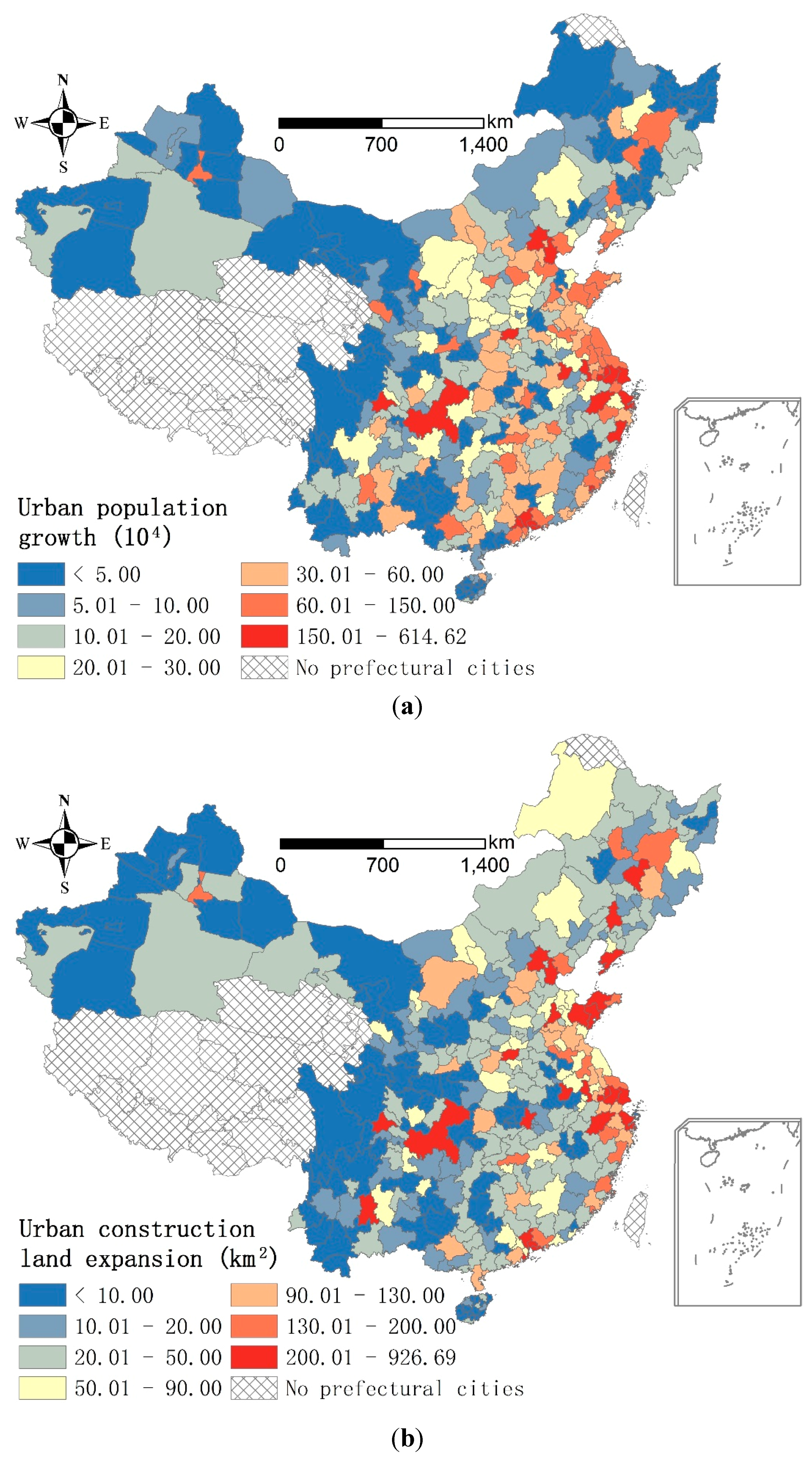
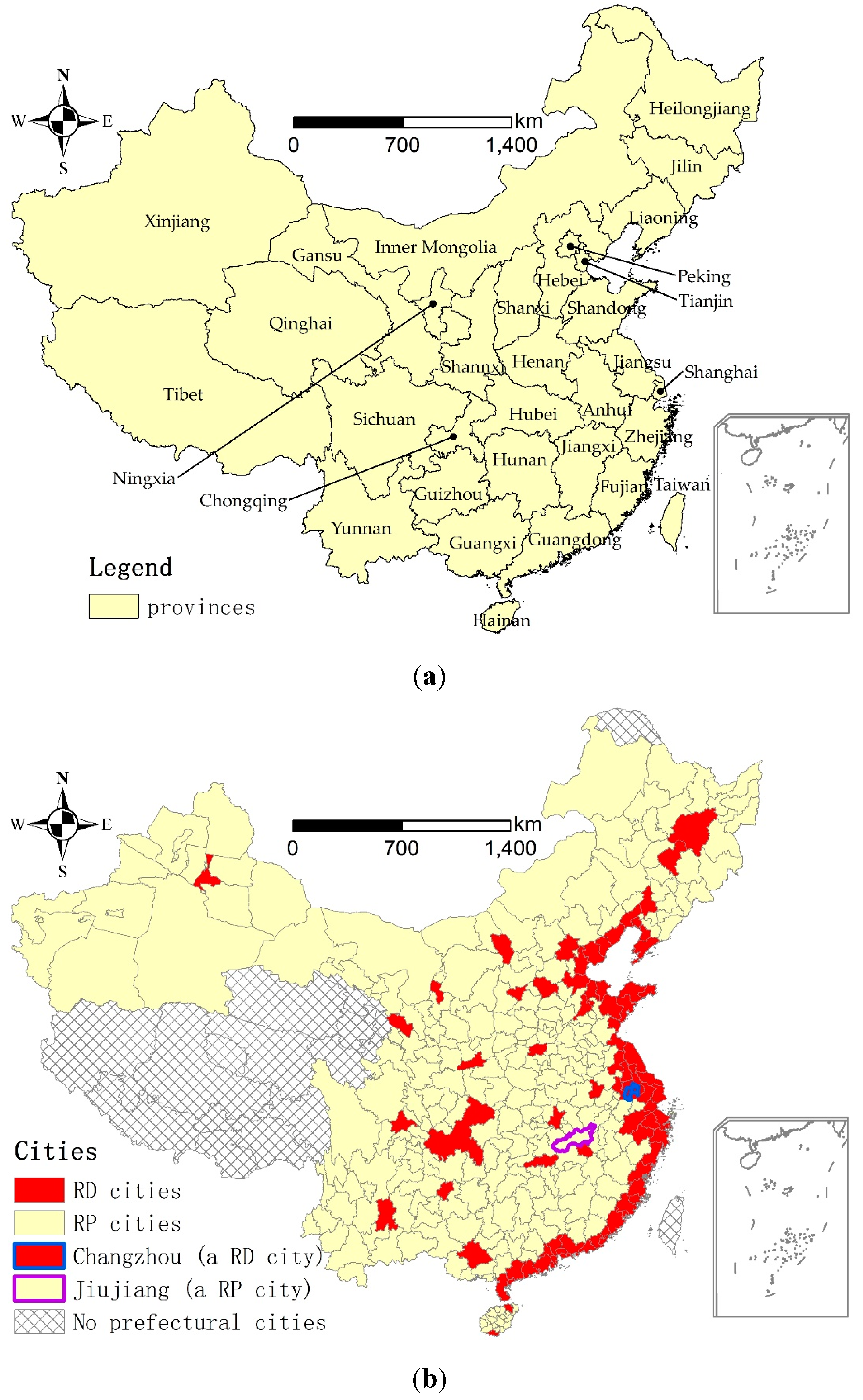
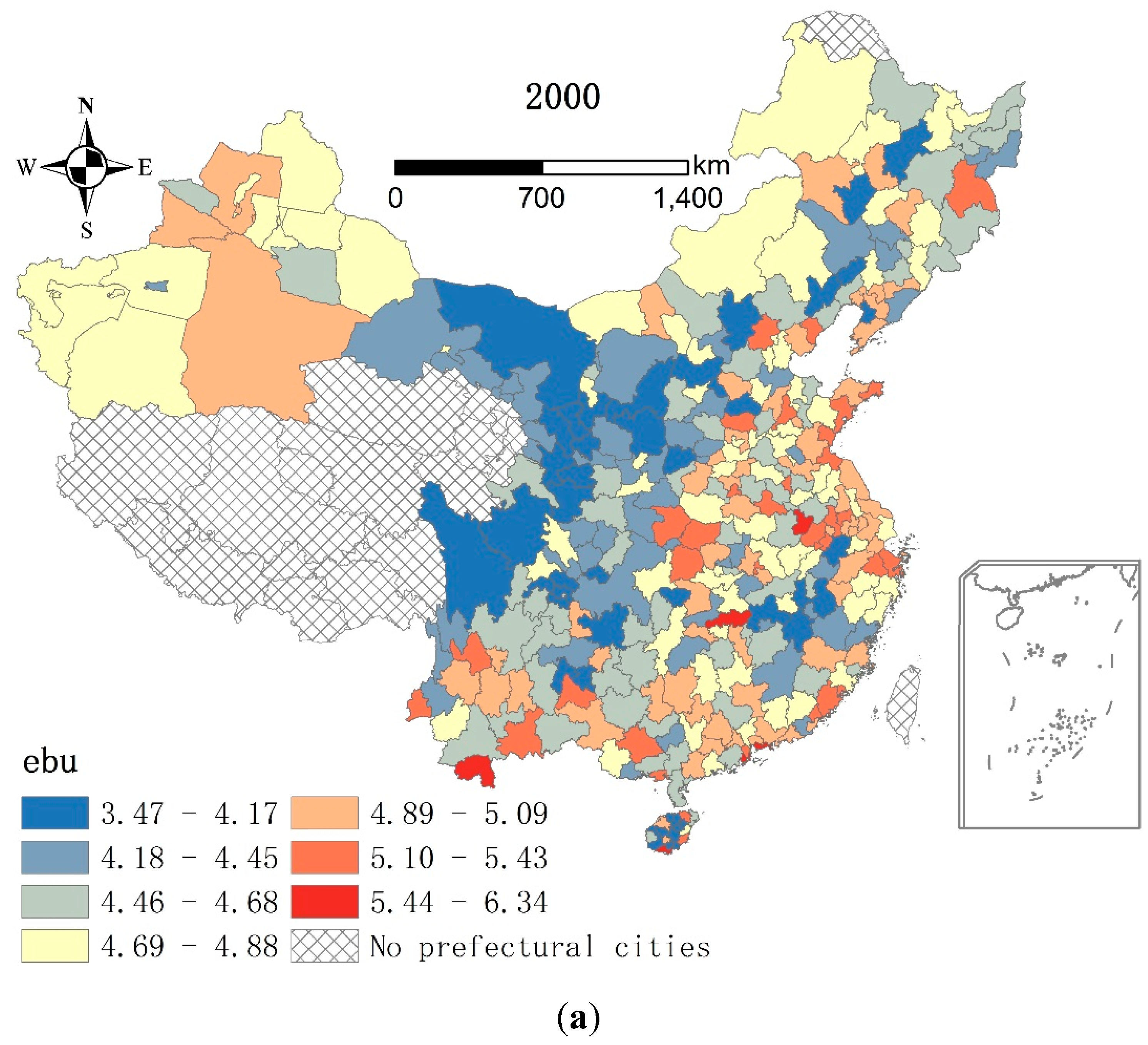
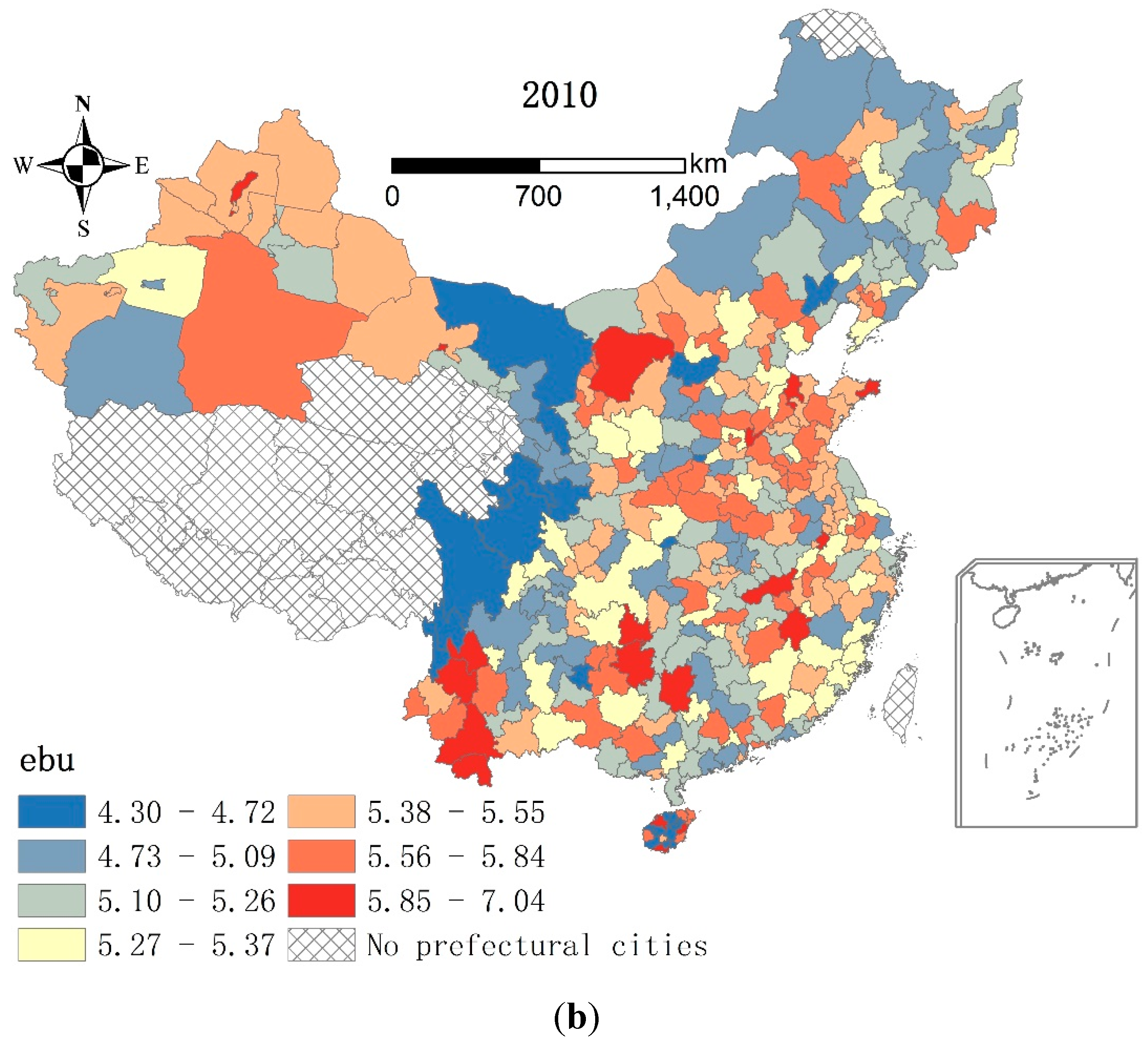
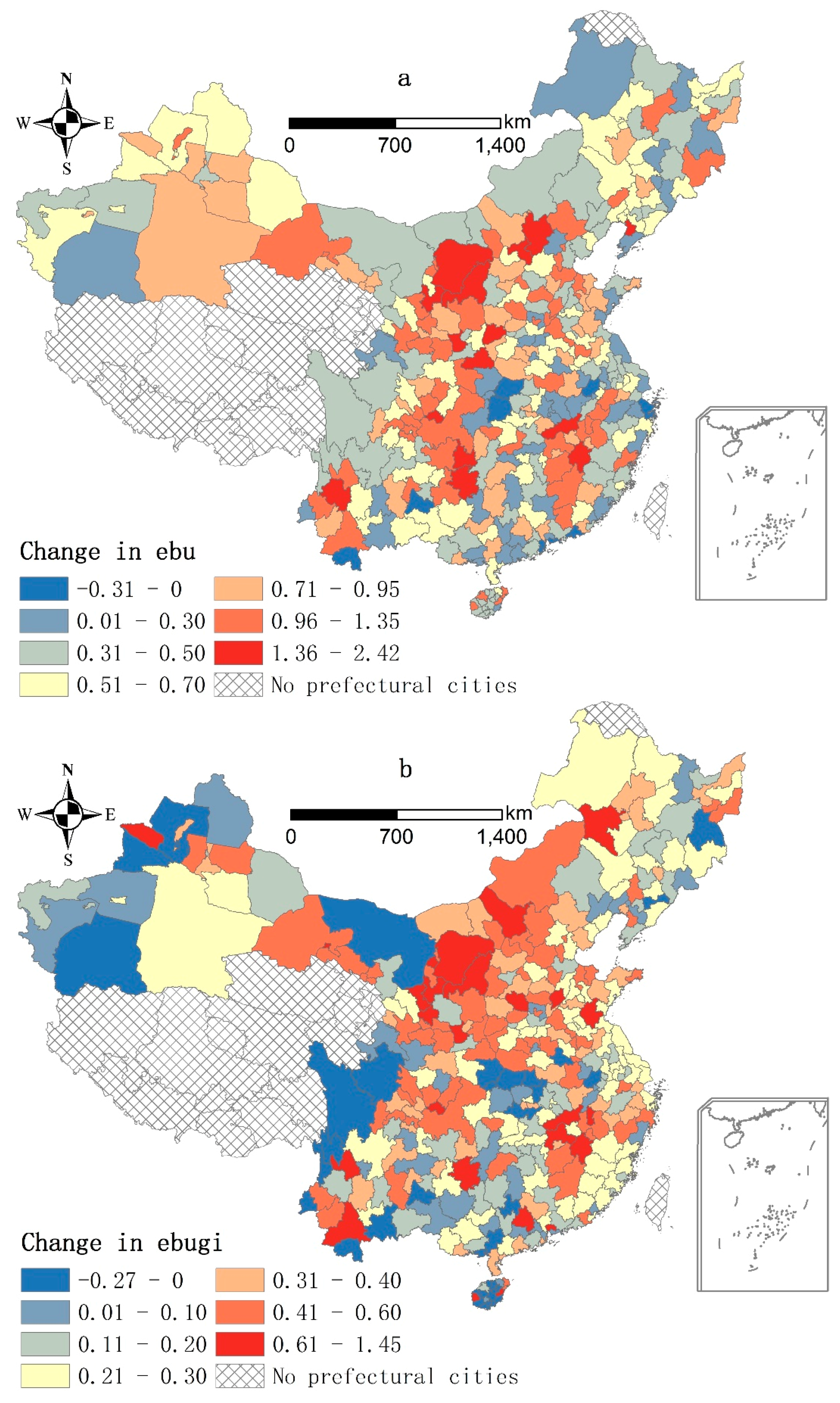
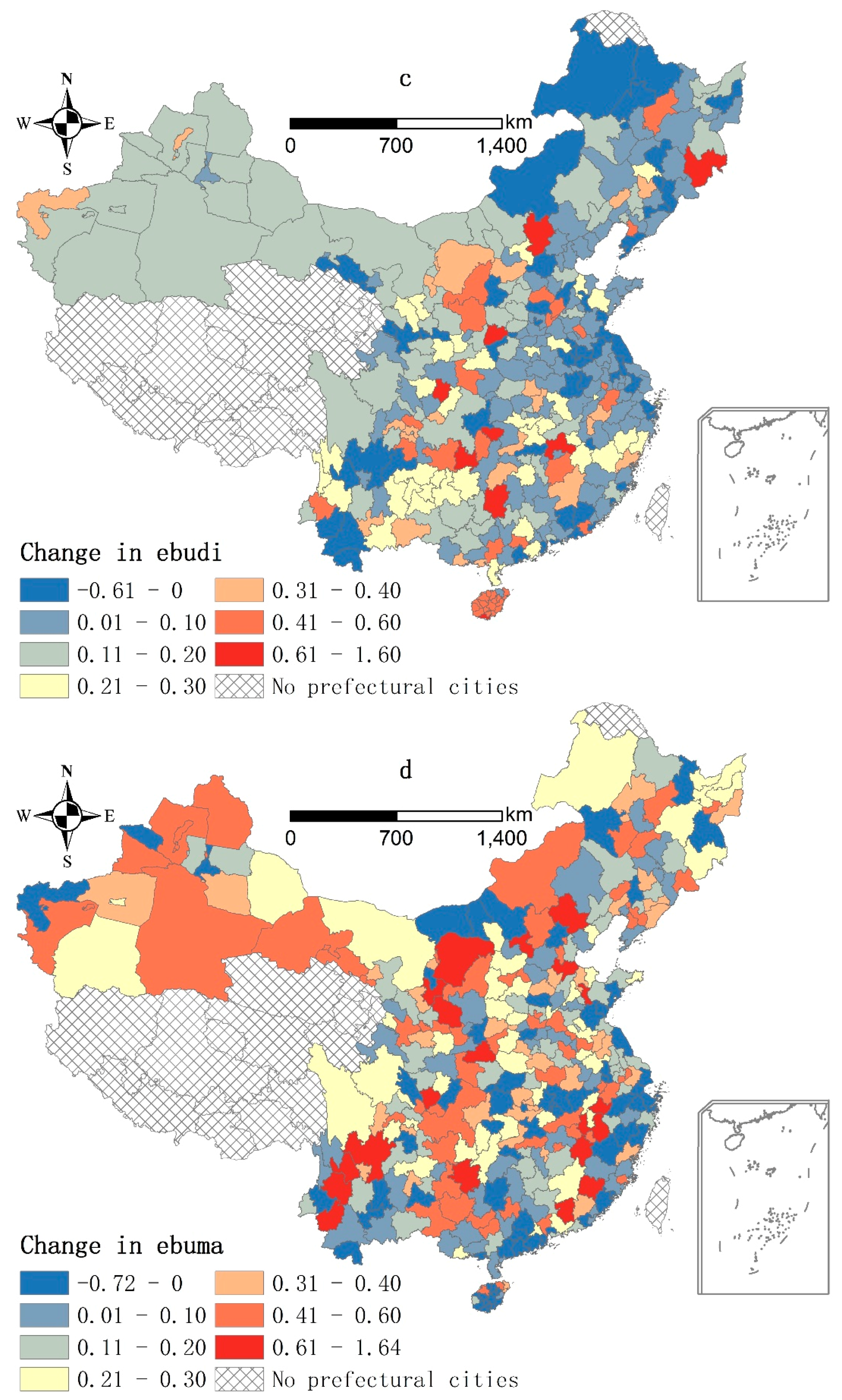



| Standard Layer | Index | Sign | Definition | Unit |
|---|---|---|---|---|
| Green infrastructure | Area of parks and green space per capita | + | The ratio of area of parks and green space to urban population | m2 |
| Density of parks and green space | + | The ratio of area of parks and green space to area of built district | % | |
| Park size | + | The ratio of park area to number of parks | hm2 | |
| Industrial upgrade | Density of industrial land | - | The ratio of industrial land area to urban construction land area | % |
| Density of industrial SO2 discharged | - | The ratio of volume of industrial SO2 discharged to urban construction land area | t/km2 | |
| Rate of discharged industrial wastewater meeting national standard | + | The ratio of volume of discharged industrial wastewater meeting national standard to volume of industrial wastewater discharged | % | |
| Environmental management | Proportion of urban maintenance and construction fund invested in environmental expenditure | + | The ratio of expenditure fund for sewerage, landscaping and environmental sanitation to the total expenditure of urban maintenance and construction fund | % |
| Intensity of urban maintenance and construction fund invested in environmental expenditure | + | The ratio of expenditure fund for sewerage, landscaping and environmental sanitation to urban construction land area | 104 yuan per km2 | |
| Disposal rate of domestic harmless garbage | + | The ratio of volume of domestic garbage harmless treated to volume of domestic garbage treated | % |
| Variable | Definition | Unit | |
|---|---|---|---|
| Per capita income | pci | Per capita disposable income of urban households | 104 yuan |
| Urban population | aup | Size of urban population | 104 |
| Per capita urban construction land area | pcucl | The ratio of urban construction land area to amount of urban population | m2 |
| Demographic urbanization | du | The ratio of amount of urban population to total amount of population | % |
| Land urbanization | lu | The ratio of urban construction land area to total land area | % |
| Cities | Number | Average Increase | Contribution (%) | |||||
|---|---|---|---|---|---|---|---|---|
| ebu | ebugi | ebudi | ebuma | ebugi | ebudi | ebuma | ||
| The whole prefectural cities | 347 | 0.638 | 0.279 | 0.151 | 0.208 | 43.682 | 23.692 | 32.626 |
| The RD cities | 81 | 0.423 | 0.260 | 0.071 | 0.092 | 61.584 | 16.775 | 21.641 |
| The RP cities | 266 | 0.703 | 0.284 | 0.175 | 0.244 | 40.403 | 24.958 | 34.638 |
| Cities | ebu | Increase | Contribution (%) | ||||||
|---|---|---|---|---|---|---|---|---|---|
| 2000 | 2010 | ebu | ebugi | ebudi | ebuma | ebugi | ebudi | ebuma | |
| Changzhou | 4.90 | 5.35 | 0.46 | 0.27 | 0.03 | 0.15 | 59.20 | 7.21 | 33.59 |
| Jiujiang | 4.62 | 5.99 | 1.37 | 0.68 | 0.14 | 0.55 | 49.64 | 10.22 | 40.15 |
| Standard Layer | Index | Changzhou | Jiujiang | ||
|---|---|---|---|---|---|
| 2000 | 2010 | 2000 | 2010 | ||
| Green infrastructure | Area of parks and green space per capita (m2) | 19.19 | 28.54 | 28.08 | 74.53 |
| Density of parks and green space (%) | 28.34 | 41.92 | 28.55 | 54.35 | |
| Park size (hm2) | 8.46 | 21.56 | 24.78 | 41.13 | |
| Industrial upgrade | Density of industrial land (%) | 32.58 | 23.84 | 24.89 | 24.01 |
| Density of industrial SO2 discharged (t/km2) | 56.10 | 14.24 | 62.50 | 3.86 | |
| Rate of discharged industrial wastewater meeting national standard (%) | 96.40 | 99.98 | 71.10 | 92.05 | |
| Environmental management | Proportion of urban maintenance and construction fund invested in environmental expenditure (%) | 21.37 | 26.94 | 23.14 | 21.93 |
| Intensity of urban maintenance and construction fund invested in environmental expenditure (104 yuan per km2) | 2.92 | 4.76 | 0.58 | 12.81 | |
| Disposal rate of domestic harmless garbage (%) | 84.05 | 98.79 | 39.11 | 79.24 | |
| ln(ebu) | ln(pci) | ln(aup) | ln(pcucl) | ln(du) | ln(lu) | ||
|---|---|---|---|---|---|---|---|
| 2000 | Mean | 1.54 | 8.63 | 4.03 | 4.30 | 3.91 | −1.01 |
| Median | 1.55 | 8.59 | 4.06 | 4.28 | 3.94 | −0.79 | |
| Maximum | 1.85 | 9.98 | 7.26 | 6.02 | 4.61 | 3.18 | |
| Minimum | 1.25 | 8.08 | 0.82 | 1.98 | 2.21 | −5.31 | |
| Std. Dev. | 0.08 | 0.27 | 1.10 | 0.45 | 0.43 | 1.44 | |
| Observations | 347 | 347 | 347 | 347 | 347 | 347 | |
| 2010 | Mean | 1.67 | 9.69 | 4.31 | 4.59 | 4.07 | −0.47 |
| Median | 1.67 | 9.65 | 4.31 | 4.56 | 4.08 | −0.36 | |
| Maximum | 1.95 | 10.48 | 7.61 | 6.31 | 4.61 | 3.71 | |
| Minimum | 1.46 | 9.02 | 1.25 | 3.20 | 3.13 | −4.74 | |
| Std. Dev. | 0.07 | 0.23 | 1.09 | 0.37 | 0.30 | 1.47 | |
| Observations | 347 | 347 | 347 | 347 | 347 | 347 | |
| Variable | 2000 | 2010 | ||||
|---|---|---|---|---|---|---|
| Coefficient | Std. Error | t-Statistic | Coefficient | Std. Error | t-Statistic | |
| Constant | −0.062 | 0.030 | −2.046 | −0.621 | 0.033 | −18.932 |
| ln(pci) | 0.161 | 0.004 | 44.744 | 0.213 | 0.003 | 61.873 |
| ln(aup) | 0.076 | 0.008 | 9.506 | 0.303 | 0.005 | 55.644 |
| ln(pcucl) | −0.008 | 0.001 | −16.041 | 0.020 | 0.001 | 21.401 |
| ln(du) | 0.053 | 0.001 | 42.810 | 0.051 | 0 | 137.783 |
| ln(lu) | −0.002 | 0 | −5.457 | −0.009 | 0 | −48.689 |
| ln(pci)×ln(aup) | −0.008 | 0.001 | −8.610 | −0.033 | 0.001 | −52.164 |
| R2 | 0.995 | R2 | 0.994 | |||
© 2016 by the authors; licensee MDPI, Basel, Switzerland. This article is an open access article distributed under the terms and conditions of the Creative Commons Attribution (CC-BY) license (http://creativecommons.org/licenses/by/4.0/).
Share and Cite
Song, X.; Chang, K.-t.; Yang, L.; Scheffran, J. Change in Environmental Benefits of Urban Land Use and Its Drivers in Chinese Cities, 2000–2010. Int. J. Environ. Res. Public Health 2016, 13, 535. https://doi.org/10.3390/ijerph13060535
Song X, Chang K-t, Yang L, Scheffran J. Change in Environmental Benefits of Urban Land Use and Its Drivers in Chinese Cities, 2000–2010. International Journal of Environmental Research and Public Health. 2016; 13(6):535. https://doi.org/10.3390/ijerph13060535
Chicago/Turabian StyleSong, Xiaoqing, Kang-tsung Chang, Liang Yang, and Jürgen Scheffran. 2016. "Change in Environmental Benefits of Urban Land Use and Its Drivers in Chinese Cities, 2000–2010" International Journal of Environmental Research and Public Health 13, no. 6: 535. https://doi.org/10.3390/ijerph13060535
APA StyleSong, X., Chang, K.-t., Yang, L., & Scheffran, J. (2016). Change in Environmental Benefits of Urban Land Use and Its Drivers in Chinese Cities, 2000–2010. International Journal of Environmental Research and Public Health, 13(6), 535. https://doi.org/10.3390/ijerph13060535








